DIY Outdoor LED
-
So, the LEDs I ordered from Ebay got lost in shipping. What are the odds. Happened maybe two times out of 250 Ebay orders. I've been refunded of course but I now doubt I will continue down this track. Thinking of going back to 230V and relays instead + some cheap fixtures from IKEA.
@activemind Not a bad idea with the flood light housing, seeing as it is so difficult to find outdoor housings. I just hope they used stainless screws and bolts.
The Arduino Pro Mini could theoretically accept 12V on the RAW pin. If that is a good idea and a long term solution I don't know. Buck converters are pretty cheap and have worked with the Pro Mini and Radio Module when I've tested them. But I'm sure if I had looked at them using an oscilloscope I would feel different.
-
I have a few nodes of Pro Minis that I power with 12VDC on the RAW pin. Have not had any trouble so far but I use high quality 12VDC power supplies that do not exceed that 12V. Exceeding 12VDC will burn the regulator on your Pro Mini. To be safe you could always add another regulator between the 12V supply and the raw pin.
-
@bjornhallberg - I looked at Ikea stuff but its too hard to modify. I did have 2 of the flood lights come in...they are 110V version, plan on disassembing one tonite. I will the pics up.
What I am thinking is take these housing and modify the LED if need be and stick one of these MySensor circuit in there. I think all can be done for < $20.
-
@korttoma - Good to know that 12V should be fine because as I posted above, I plan on using the above housing and modify it for 12V DC operation. I have a server grade high amp 12V DC power supply that I plan on using for all these lights and it would be good if I could use the same 12V for powering mySensor node as the LEDs.
-AM
-
I can't say the same as @korttoma --- I burned some pro minis (in fact, cheap clones) by applying 12V at RAW pin. I think the on-board regulator of my clones has 12V as absolute maximum. And I had to learn it in the hard way...

After i to put a 78L05 between 12V and Arduino's VCC pin (as well as a 78L33 between 12V and radio), everything worked pretty well.
-
@rvendrame yeah, that is how I would recommend to do also. An additional regulators are worth it, just to be safe.
-
Bringing back and old thread from the dead as I have some time now to spend on this.
Did some more research on Amazon and ended up ordering these LED lights
Planning on using MYS board to control these.
http://forum.mysensors.org/topic/207/my-sensorboard-mys-1-0beta
I have 2 questions:
-
These are 12V and MyS board can take 12V input too. So I can power them off using the same 12V wire. Shall I use a relay to control these lights ? Couldnt find the current draw but I plan on measuring it once I get them in.
-
Should I try to embed the myS board in the light case or look into an external waterproof plastic box? These are going to be outdoors.
-AM
-
-
@activemind said:
- These are 12V and MyS board can take 12V input too. So I can power them off using the same 12V wire. Shall I use a relay to control these lights ? Couldnt find the current draw but I plan on measuring it once I get them in.
They are rated for 5W. 12V/5W=2,4A
Edit: NO, 5W/12V=0.42A. My bad.
-
@activemind said:
- Should I try to embed the myS board in the light case or look into an external waterproof plastic box? These are going to be outdoors.
The case seems to be made if aluminum. That will probably block radio signals. So if you're planning to use radio, go for a plastic box.
-
Thanks for the feeback. You make good points. I will plan for an external waterproof box for all mysensors circuitry.
Does using a FET sound good or shall I use a relay?
Something like this should be pretty inexpensive..
-AM
-
Or something like this would be better:
-AM
-
There is no information on which mosfet in the ebay listing. I would one that has a name/number so the data sheet can be looked up. The MySensors store recommends IRLZ44N.
Downside with mosfet: can become hot, might need a heat sink
Upside with mosfet: can be used to dim the lightsBy the way, how are you planning to get the power to the units? 12V from your house into the garden? In that case you might get problems if your garden is large, transferring power over long distances with low voltage is hard.
-
Will the FET get hot even with 2.4A when its rated for much more?
I am thinking of building one node and trying it out to see if there is any fallout. This will be for my landscape lights so its not like it will be running 24/7.
The plan IS to run a 14/2 wire running 12V. I could do 12/2 if the voltage drop is too bad. My runs should not be obscenely long...I guess I will have to just try and see what the drop is.
Thanks again for all your feedback.
-AM
-
@activemind said:
Will the FET get hot even with 2.4A when its rated for much more?
Probably not. As long as you check the rating you should be fine.
The plan IS to run a 14/2 wire running 12V. I could do 12/2 if the voltage drop is too bad. My runs should not be obscenely long...I guess I will have to just try and see what the drop is.
14 AWG has a resistance of 0.00829 ohm per meter (source). Assuming you have 15m from the outlet to the light, the resistance in the cable will be 0.2487 ohm (0.00829 * 15 * 2). At 2.4A that will result in a voltage drop of 2.4 * 0.2487=0,60V. That shouldn't be a problem.
If the distance from the outlet to the lights is longer, and you want to connect multiple lights without running multiple cables, the calculation doesn't look very good. Let's say the cable needs to be 30m and you want 5 lights, then we have a cable resistance of 0.00829 * 30 * 2=0.5 ohm and a voltage drop of 2.4 * 5 * 0.5=6V

12 AWG will give you 0.00521 * 30 * 2=0.3126 ohm and 2.4 * 5 * 0.3126=3,75V voltage drop which also might be too much.
-
I would put my distance around 20m so that should be okay but I DO plan on putting multiple of these on a single run hence larger current!
I really dont want to do multiple runs.
Two options:
- I need to see how bright the light is with < 12V ?
- Use some regulator to bump up the voltage at the location. I will be building a seperate box anyways to house the FET and MySensors circuitry, so maybe put a regulator there?
What do you think?
-AM
-
Option 2 would require larger current (2.4A at 12V will require at least 4.8A at 6V) so the problem just gets worse. Better to increase the voltage, maybe run 24V and regulate down to 12V at each light?
-
@mfalkvidd
But i already have server grade 12v power supplies and i dont want to buy new ones.Is the LED really going to draw 2.4A? I will hook up one today and measure.
What's the max safe amount of current i can carry on 14/2 LV wire?
If push comes to shove, i might do multiple runs

-AM
-
Each led would draw around 410ma
5/12=.416
-
According to http://www.powerstream.com/Wire_Size.htm the limit for 14 awg is 5.9A.
-
@Boots33 correct! I edited my previous calculation. Sorry for misleading you @activemind My voltage drop calculations are off by 5x so you will be able to use 5 lights instead of 1 at 2.4A. That means you'll only get in trouble if you plan to use 20+ lights.
-
-
Slightly off topic question, but I am looking for a benchtop power supply (yeah! been managing without one for so long) and wanted y'all opinion on this:
Or
Or something else that doesnt cost a fortune.(<$100).
-AM
-
Or this one looks interesting too...good reviews on Amazon
-
Ended up blowing the regulator on a 5V pro mini when powered at 12V. Maybe its the "clone" part from china that is causing this but it gave out smoke and finally died when powered at 9V.
Going to assemble another 5V pro mini and power at 5V to test the board and circuit.
Thinking about putting a hefty 150R 1W ressistor before feeding 12V to RAW in final circuit.
Thoughts?
-AM
-
You could also use an external regulator module to supply the 5v. at the moment you are running right on the pro mini maximum voltage which in my mind is never a good thing for long term reliability. I have used these modules with great success, they work with a wide level of input voltage and can be adjusted, so can be set to 5v or 3v output . They are quite cheap as well so if you have the room they may be worth a look.
-
Yeah, those would work good and I can feed 5V rather than 12V ar RAW pin.
How are these adjusted to output 5V?
edit: nevermind, I see the pot screw to adjust the output voltage.
-AM
-
assembled another pro mini board and powered it using 5V wall wart this time, no 3v3 on the board. I think I blew 662K part too.
Let me try replacing it.
-AM
-
replaced the 662K part and now it seems to be working fine. I dug up my stash and found one step down converter like above. Let me power the node using it and see how it goes.
-AM
-
Powering a motion sensor sketch using the buck converter above. I wish I had my 12V relays in...
Here is a pic:
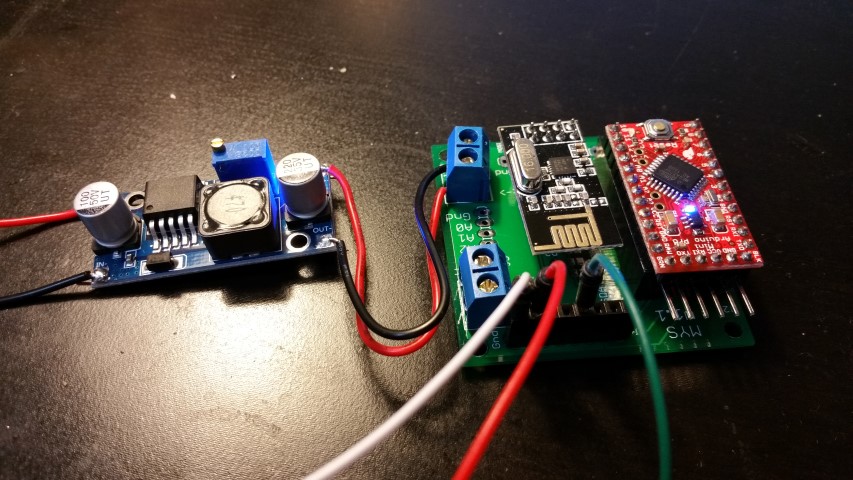
-
Connected the whole thing up....working nicely.
Though I do see a flicker when I try to dim it...
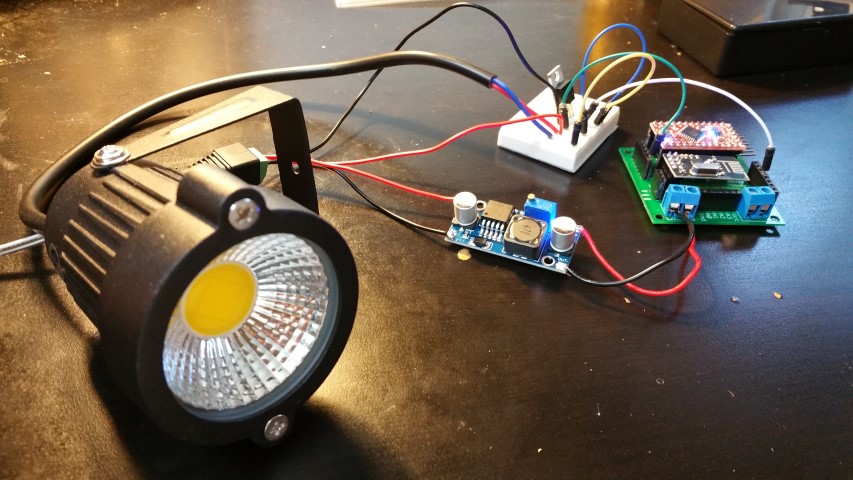
-
Figured out the flicker issue, it was the power supply. I was using a puny 750mA wall wart which could handle the PWM duty cycle. Once I put my hefty 12V power supply, its behaving fine.
I built a perfboard and the FET and was able to fit everything in a plastic DIY box from ebay.
How do I weatherize this because this will be outside exposed to elements? Also thinking of making some holes in the box to vent out some heat.
Whats the best way to do this?
-AM
-
Ready to rock n roll...
Packaging is done though I dont know how weatherproof this is going to be..
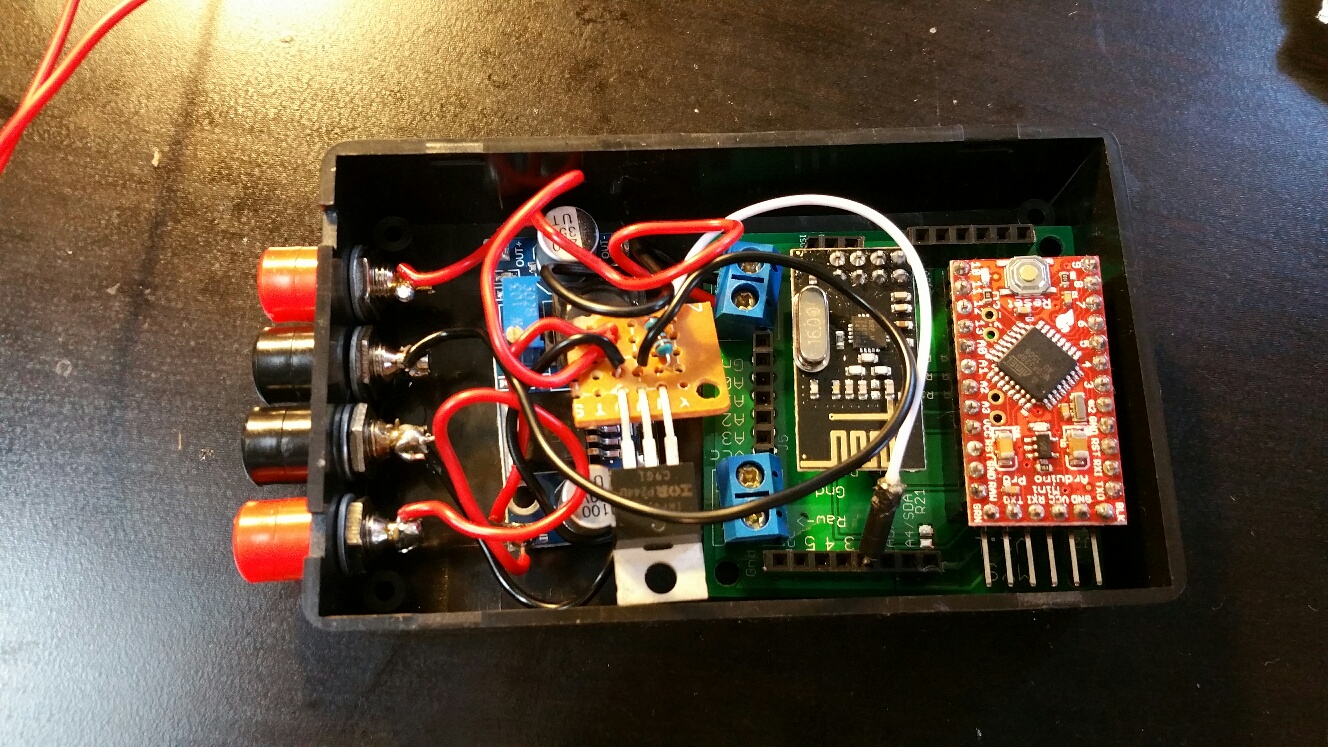
-
@activemind looks good. I use these boxes outside. Just turn it upside down and your circuit should be protected from rain. I'm not sure your connectors will survive on the long run. (in fact i'm sure they won't
 )
)
-
Thanks for your response. Whats my other options for connectors? I really dont want to hardwire it.
-AM
-
@activemind you could either:
- use waterproof connectors
- don't use connectors and apply some sealing kit
- ignore the rusting and take action when it stops working

-
I think i will go with option#3 for now. These are landscape lights...world won't end if they go off after some time.
Lets see how long it lasts and if its too short then i could look at other options.
Plan to build 9 more of these ( total 10) and run some 14/2 LV this weekend. Will post pics when done.
I tested the light last night at its prospective location and it works like a champ. Nrf range aint that bad for the price

-AM
-
Something like this might be useful if you decide to go for waterproof connectors https://www.adafruit.com/product/743
-
@mfalkvidd Those connectors look intersting, let me look at them in more detail.
First one deployed today. Scheduled to come on at dusk and turn off at 10PM through Vera.
Will update with a pic in action.Went ahead and ordered 8 more and now need to assemble the "mysensor boxes" for them.
-AM
-
I changed the banana plugs to regular DC 2.1mm plugs and it looks less cluttered now.
Deployed it yesterday. Looks good.
Will upload pics if someone is interested.
-AM
-
Pics are always good. Please do upload
-
Here are some pics of the "final" product:
Thanks to everyone for their input.
-AM
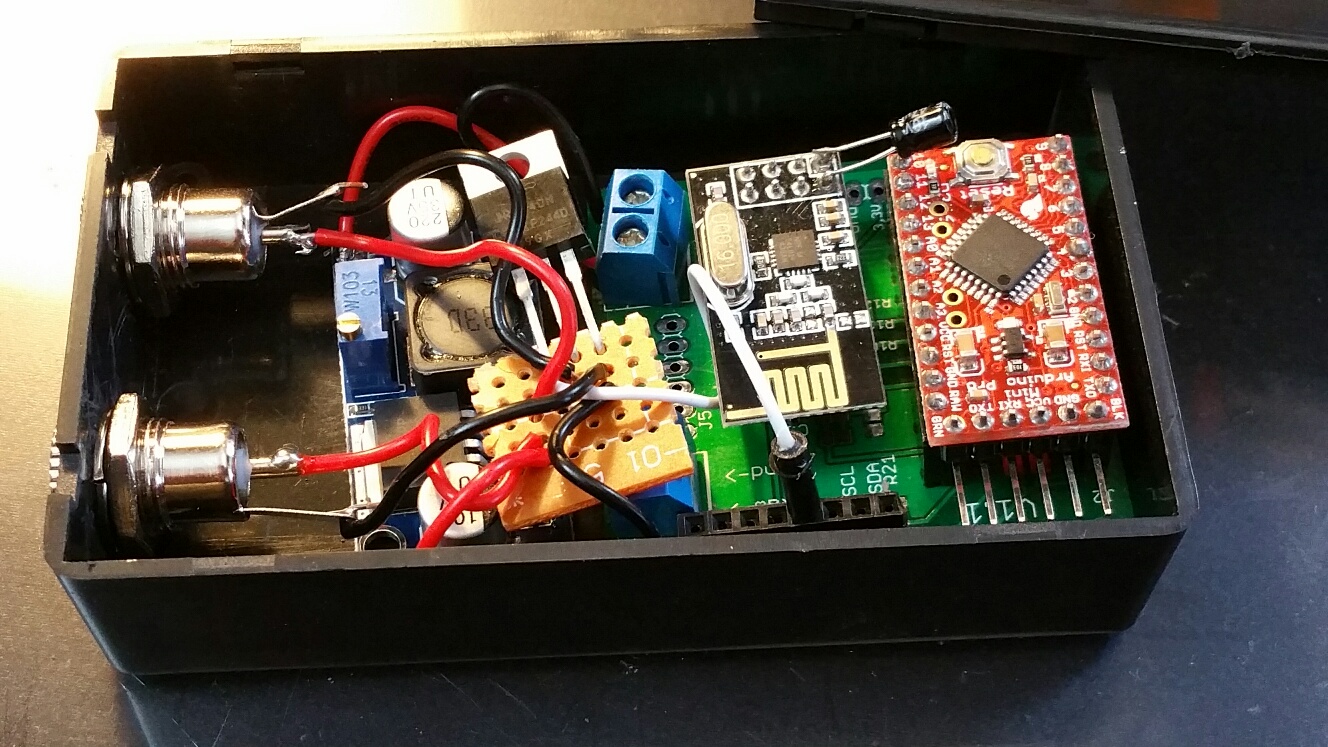
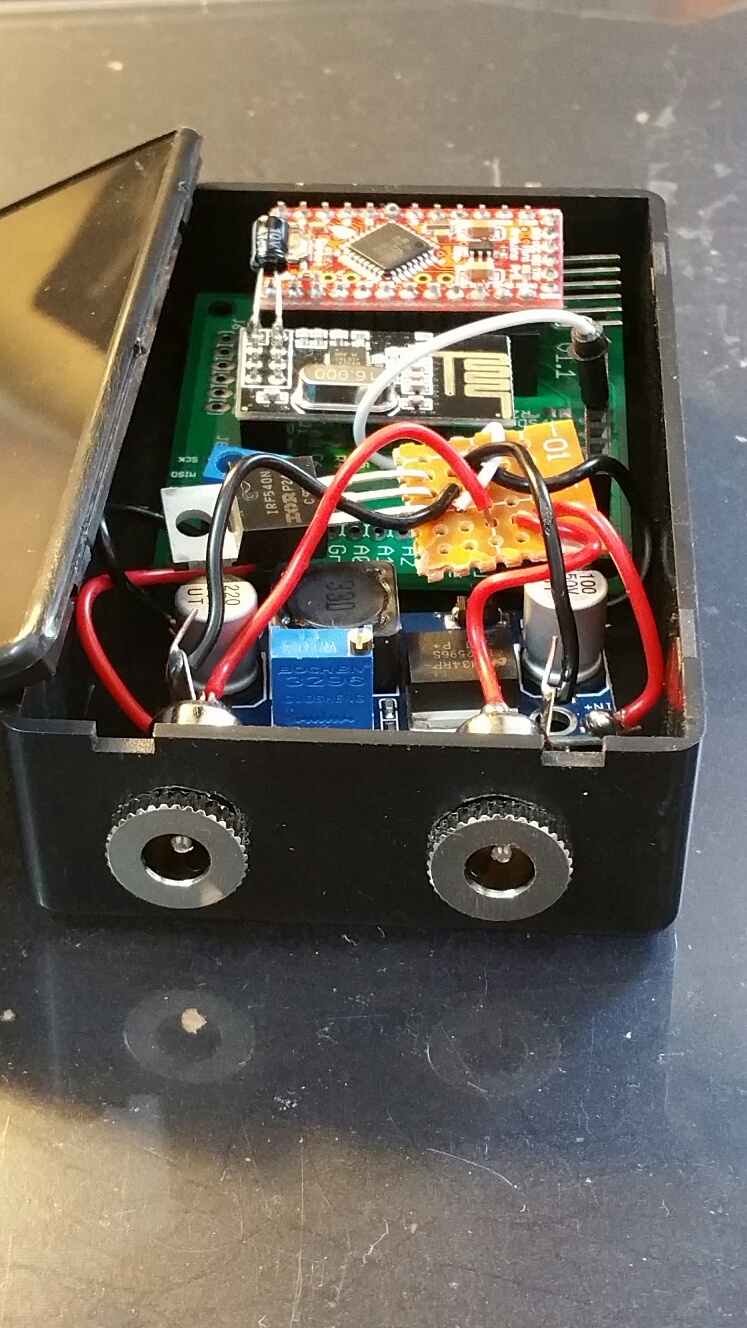
-
So I deployed 5 more of these yesterday, so I have a total of 6 on the chain now.
The total current draw is ~5A at 12V...not bad!
Though I have an issue where the lights will go off for a little bit and then come back on.
Almost all of them are doing this and it doesnt happen at the same time so its not that the power is interrupted.
Makes me think as if the LED is heating up and shutting down and then when it cools down after a bit, it comes back on.
I tested them prior to deployment to make sure that they worked but didnt run them long enough that they would heat up. Plan on putting up one on the bench and leave it on longer to see if it does that.
But overall, not bad landscape light for 10 bucks!
-AM
-
Update: The landscape light are programmed to come on in the evening and they did not turn on this evening. Further investigation yielded this:

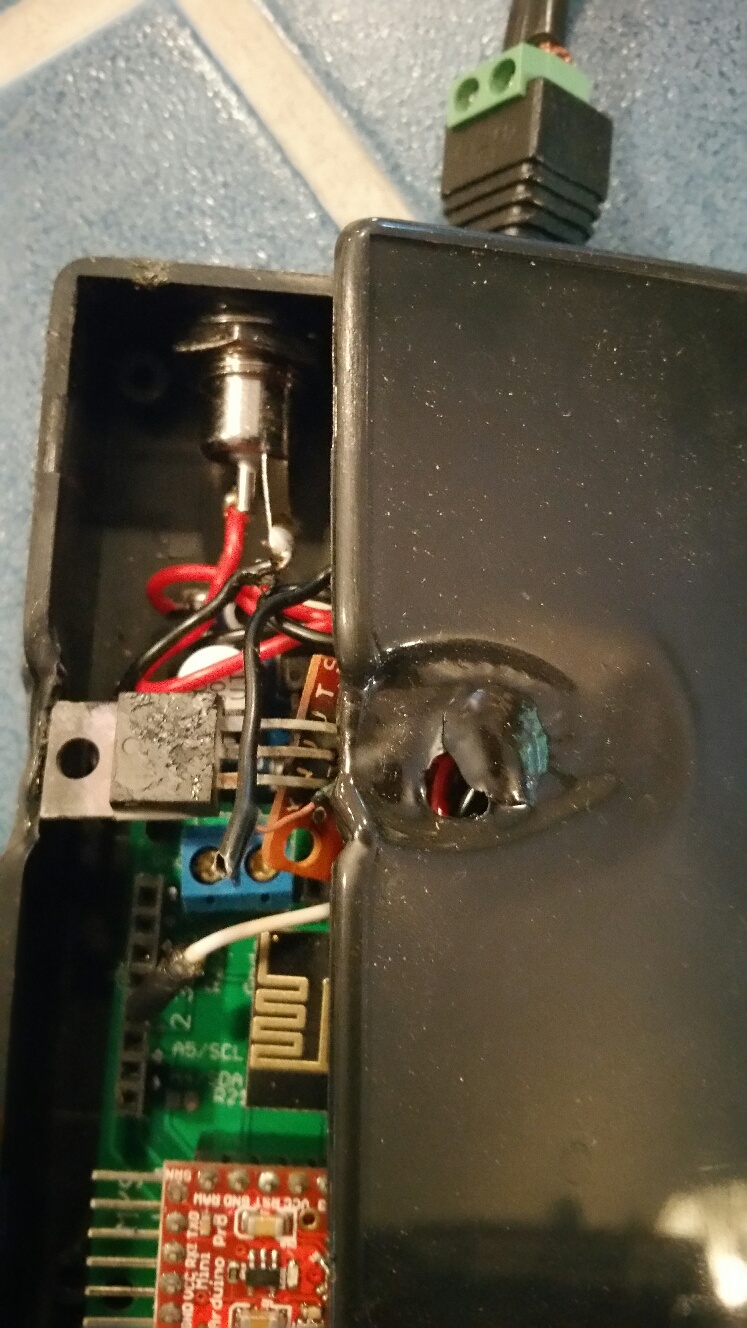
The FET was touching the plastic case and melted it

-AM
-
This might help a bit http://www.aliexpress.com/item/10pcs-Free-Shipping-Aluminium-TO-220-Heatsink-TO-220-Heat-Sink-Transistor-Radiator-TO220-Cooler-Cooling/32684240364.html
-
@activemind are you dimming the led or only switch it? A (swich) fet in full saturation should have an internal resistance of less than 0.1 ohm. It would be hard to get it heated that much with a current in the range of 1 amp..
It could well be that your fet is not in full saturation. Take a look at the data sheet..
-
@mfalkvidd said:
This might help a bit http://www.aliexpress.com/item/10pcs-Free-Shipping-Aluminium-TO-220-Heatsink-TO-220-Heat-Sink-Transistor-Radiator-TO220-Cooler-Cooling/32684240364.html
Yup! I have them on order from China. Will try but I think I need to perforate the box too. Its drwaing ~5A which is amlost 60W. Maybe a little too much for a totally closed box!
-AM
-
@AWI said:
@activemind are you dimming the led or only switch it? A (swich) fet in full saturation should have an internal resistance of less than 0.1 ohm. It would be hard to get it heated that much with a current in the range of 1 amp..
It could well be that your fet is not in full saturation. Take a look at the data sheet..I am dimming as well as turning them on/off. There are 6 such lights on this FET and when all are on, the draw is around 5A. I am guessing thats a little too much for this tiny heatsink in an enclosed box. Need to change the heatsink and perforate the box.
Thanks for the datasheet reminder. Let me go back and check whats the power I am dissipating when dimming these lights.
-AM
-
Yup! I have them on order from China. Will try but I think I need to perforate the box too. Its drwaing ~5A which is amlost 60W. Maybe a little too much for a totally closed box!
Most of the power will be dissipated in the lights. The power dissipated in the FET is the FET's resistance * current^2. If you are using a IRLZ44N FET I think that means 0.025 * 5^2 = 0.625W if you give the FET a signal of 5V. (0.025 ohm is the Static Drain-to-Source On-Resistance from the datasheet)
-
@mfalkvidd said:
Yup! I have them on order from China. Will try but I think I need to perforate the box too. Its drwaing ~5A which is amlost 60W. Maybe a little too much for a totally closed box!
Most of the power will be dissipated in the lights. The power dissipated in the FET is the FET's resistance * current^2. If you are using a IRLZ44N FET I think that means 0.025 * 5^2 = 0.625W if you give the FET a signal of 5V. (0.025 ohm is the Static Drain-to-Source On-Resistance from the datasheet)
Heat dissapation in the lights is another issue I need to look into because with this new batch I ordered, they have been turning off after like 5 mins and then come back on by themselves. I think the heat sink on this new batch is not that good because the last batch did not do this.
I am using them at 12V so the power would be ~4W. Not too much but still enough to get the sink hot!
-AM
-
I am using them at 12V so the power would be ~4W. Not too much but still enough to get the sink hot!
The voltage makes no difference. 5A is still 5A.
-
@mfalkvidd said:
I am using them at 12V so the power would be ~4W. Not too much but still enough to get the sink hot!
The voltage makes no difference. 5A is still 5A.
you are right
 brain fart
brain fart
 -Outdoor-Decorative-Lighting-Landscape/dp/B012VLSYJE?ie=UTF8&psc=1&redirect=true&ref_=oh_aui_detailpage_o00_s00
-Outdoor-Decorative-Lighting-Landscape/dp/B012VLSYJE?ie=UTF8&psc=1&redirect=true&ref_=oh_aui_detailpage_o00_s00